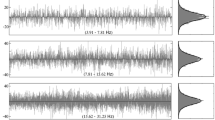Abstract
Conventional methods for monitoring clinical (epileptiform) multichannel electroencephalogram (EEG) signals often involve morphological, spectral or time-frequency analysis on individual channels to determine waveform features for detecting and classifying ictal events (seizures) and inter-ictal spikes. Blind source separation (BSS) methods, such as independent component analysis (ICA), are increasingly being used in biomedical signal processing and EEG analysis for extracting a set of underlying source waveforms and sensor projections from multivariate time-series data, some of which reflect clinically relevant neurophysiological (epileptiform) activity. The work presents an alternative spatial approach to source tracking and detection in multichannel EEG that exploits prior knowledge of the spatial topographies of the sensor projections associated with the target sources. The target source sensor projections are obtained by ICA decomposition of data segments containing representative examples of target source activity, e.g. a seizure or ocular artifact. Source tracking and detection are then based on the subspace correlation between individual target sensor projections and the signal subspace over a moving window. Different window lengths and subspace correlation threshold criteria reflect transient or sustained target source activity. To study the behaviour and potential application of this spatial source tracking and detection approach, the method was used to detect (transient) ocular artifacts and (sustained) seizure activity in two segments of 25-channel EEG data recorded from one epilepsy patient on two separate occasions, with promising and intuitive results.
Similar content being viewed by others
References
Bankman, I. N., Johnson, K. O., andSchneider, W. (1993): ‘Optimal detection, classification, and superposition resolution in neural waveform recordings’,IEEE Trans. Biomed. Eng.,40, pp. 836–841
Bell, A. J., andSejnowski, T. J. (1995): ‘An information-maximization approach to blind separation and blind deconvolution’,Neural Comput.,7, pp. 1483–1492
Cichocki, A., andAmari, S. (2002): ‘Adaptive blind signal and image processing: learning algorithms and applications’ (John Wiley & Sons Ltd, 2002)
Dingle, A., Jones, R., Carroll, G., andFright, R. (1993): ‘A multi-stage system to detect epileptiform activity in the EEG’,IEEE Trans. Biomed. Eng.,40, pp. 1260–1268
Flanagan, D., Agarwal, R., andGotman, J. (2002): ‘Computer-aided spatial classification of epileptic spikes’,J. Clin. Neurophysiol.,19, pp. 125–135
Gotman, J. (1999): ‘Automatic detection of seizures and spikes’,J. Clin. Neurophysiol.,16, pp. 130–140
Hesse, C. W., andJames, C. J. (2004): ‘A time-frequency approach to blind source separation using statistically optimal wavelet packets applied to ictal EEG’. Proc. 2nd IEE Medical Signal & Information Processing Conf., pp. 137–144
Hyvärinen, A., andOja, E. (1997): ‘A fast fixed-point algorithm for idependent component analysis’,J Neural Comput.,9, pp. 1483–1492
Hyvärinen, A., Karhunen, J., andOja, E. (2001): ‘Independent component analysis’ (John Wiley & Sons, New York, 2001)
James, C. J., Jones, R. D., Bones, P. J., andCarroll, G. J. (1999): ‘Detection of epileptiform discharges in the EEG by a hybrid system comprising mimetic, self-organized artificial neural network, and fuzzy logic stages’,Clin. Neurophysiol.,110, pp. 2049–2063
James, C. J., andHesse, C. W. (2005): ‘Independent component analysis for biomedical signals’,Physiol. Meas.,26, pp. R15-R39
Jung, T. P., Makeig, S., Humphries, C., Lee, T. W., McKeown, M. J., Iragui, V., andSejnowski, T. J. (2000): ‘Removing electroencephalographic artifacts by blind source separation’,Psychophysiol.,37, pp. 163–178
Kobayashi, K., James, C. J., Nakahori, T., Akiyama, T., andGotman, J. (1999): ‘Isolation of epileptiform discharges from unaveraged EEG by independent component analysis’,Clin. Neurophysiol.,110, pp. 1755–1763
Kobayashi, K., James, C. J., Yoshinaga, H., Ohtsuka, Y., andGotman, J. (2000): ‘The electroencephalogram through a software microscope: Non-invasive localization and visualization of epileptic seizure activity from inside the brain’,Clin. Neurophysiol.,111, pp. 134–149
Ossadtchi, A., Baillet, S., Mosher, J., Thyerlei, D., Sutherling, W., andLeahy, R. (2004): ‘Automated interictal spike detection and source localization in magnetoencephalography using independent components analysis and spatio-temporal clustering’,Clin. Neurophysiol.,115, pp. 508–522
Wax, M., andKailath, T. (1985): ‘Detection of signals by information theoretic criteria’,IEEE Trans. Acoust., Speech Signal Process.,33, pp. 387–392
Wax, M., andZiskind, I. (1989): ‘Detection of the number of coherent signals by the MDL principle’,IEEE Trans. Acoust., Speech Signal Process.,37, pp. 1190–1196
Wilson, S. B., andEmerson, R. G. (2002): ‘Spike detection: A review and comparison of algorithms’,Clin. Neurophysiol.,113, pp. 1873–1883
Wilson, S. B., Scheuer, M. L., Emerson, R. G., andGabor, A. J. (2004): ‘Seizure detection: Evaluation of the reveal algorithm’,Clin. Neurophysiol.,115, pp. 2280–2291
Author information
Authors and Affiliations
Corresponding author
Rights and permissions
About this article
Cite this article
Hesse, C.W., James, C.J. Tracking and detection of epileptiform activity in multichannel ictal EEG using signal subspace correlation of seizure source scalp topographies. Med. Biol. Eng. Comput. 43, 764–770 (2005). https://doi.org/10.1007/BF02430955
Received:
Accepted:
Issue Date:
DOI: https://doi.org/10.1007/BF02430955




